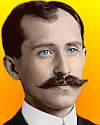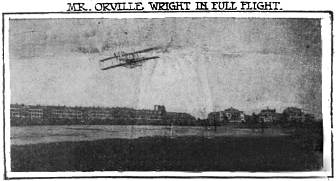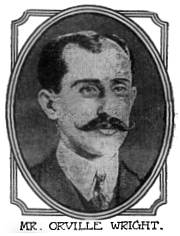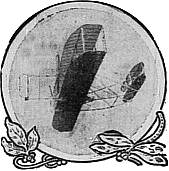 (source)
(source)
|
Orville Wright
(19 Aug 1871 - 30 Jan 1948)
American inventor and aviator , who with his brother, Wilbur, invented the first powered airplane, Flyer, capable of sustained, controlled flight (17 Dec 1903). At Kitty Hawk, North Carolina, Orville made the first ever manned powered flight, airborn for 12 sec.
|
Newspaper Reports of Orville Wright’s Crash
Paris Herald, Sept 18, 1908
BADLY INJURING TWO MEN





WASHINGTON, Thursday.— As a result of an accident to the Wright aeroplane at fort Meyer, this afternoon, the machine, while sailing, crashed to the ground, and Mr. Orville Wright and Lieutenant Thomas E. Selfridge were seriously injured.
Mr Wright’s left thigh was broken and he suffered severe cuts on the head. He will be unable to fly again this year.
It is believe that Lieutenant Selfridge was even more seriously injured. He received severe wounds on the head.
Mr. Wright’s machine was badly damaged.
The machine turned completely over, falling at least seventy-five feet.

The general opinion seems to be that part of one propeller of the aeroplane broke off from the strain of the flights.
New propellers which had not yet been tried were put on yesterday in place of those Mr. Wright has been using. The propellers were six inches longer than the older ones and of slightly less pitch.
Other accounts have it that one whole propeller flew off in the air.
The accident happened very suddenly without warning and without any preliminary wavering or erratic movement to indicate that trouble was forthcoming. Not ten minutes before the flight began the HERALD correspondent said to Lieutenant Selfridge: “There is one man on this field who will envy you every minute.” He does not envy him now.
Major Squier, who accompanied Mr. Wright on the record-breaking flight on Saturday, is greatly concerned.
At 5.14 o’clock Lieutenant Selfridge and Mr. Wright started to beat the world’s record in an aeroplane for two men.
The machine got a good start, but after three minutes’ flight, at an altitude of about 100ft., the trouble occurred.
The crowd, which had forgotten to draw its breath until the launch with the passenger was safely accomplished, had just begun to breathe freely again and Mr. Wright was apparently making the best progress over the parade ground, when suddenly a snap was heard and the machinery of the aeroplane seemed to groan and cry as if alive. Pieces of the propeller were seen falling to the earth and in a second the machine, losing its momentum, shot downward.
Down, down it came, held somewhat by the canvas of the construction, but falling rapidly with the weight of the two men, and crashed to the greensward like a bird with a broken wing.
The aeroplane landed upon its side.
Those who reached the machine first found Lieutenant Selfridge and Mr. Wright imbedded in the mass of wreckage, from which they were quickly extracted. Lieutenant Selfridge appeared to be the worse injured, although at first the doctors refused to give an official opinion. One long, ragged tear extended from near the crown of the head to the chin.
Both men were under the machine when it struck the earth. The guards were unable to control the crowd and the soldiers joined in rushing to the scene of the accident.
The machine was lifted by willing hands and the two men were borne to a hospital upon stretchers hastily brought by attendants, who had seen the falling aeroplane. An examination on the field was not attempted.
Lieutenant Selfridge was unconscious from the time of the fall until after he reached hospital. Mr. Wright was conscious shortly after being taken out of the machine, but could say nothing about the accident, He seemed to be in a dazed condition.
An official bulletin at 6.35 o’clock said that Mr. Wright had sustained a fracture of the left thigh and several ribs on the right side. He also was cut about the head and was much shocked by the accident but rested well. He is conscious and will recover.
Lieutenant Selfridge sustained a fracture of the base of the skull and cuts about the face. He is in critical condition. Dr. Crosby, Dr. McCaw and Dr. Ireland, who were present as spectators were pressed into service and with Captain Bailey, the post surgeon, were soon in attendance.
A hasty survey of the aeroplane indicates that it was seriously damaged. It turned as it fell and the men spilled from the little seat they occupied, together, as it neared the ground.
The machine was splintered in many places and will have to be entirely rebuilt, with the exception of the cloth, which, while pierced in many places, can probably be utilized. Both propellers have all blades splintered off close to the shafts. The engine probably will be in condition to be used after repairs have been made, but this cannot be accurately ascertained until after a careful examination.
After the accident the aeroplane was taken to pieces and removed to the balloon shed. As the machine fell the front steering planes which project forward struck first. The long planes stood upright, flat in the air, resting upon the steering planes. When the spectators reached the machine Lieutenant Selfridge tried to speak, then lapsed into unconsciousness.
As the crash came one of the correspondents of the HERALD was telephoning the news of the flight to the Washington Bureau. From the official tent on the aeronautical field could be hear the crash over the telephone. The news was flashed to the direct cable wire for Paris as soon as the crashing could be explained.
The time for delivery of the Wright machine expires on September 28. General Luke Wright, Secretary of War, will undoubtedly make an exception and extend the time for Mr. Wright to deliver the aeroplane. General regret was expressed on all sides as the news of the accident was flashed here. Diplomatists, and army and navy officers who were unable to attend the flight were much concerned as to the condition of both men.

Mr. Wright had been warned lately by Mr. Charles R. Flint, who has the European patents on his aeroplane, and others to be especially careful about seeing that his machine was in excellent working order before attempting flights. He was told that danger would be minimized if a minute examination of his necessarily frail machine were made each day before the start. The aeronaut, however, was willing to risk much in order to demonstrate to the world that he could fly and did not pay unusual heed to these precautions.
“I know I am in danger daily,,” he said, “but ‘nothing risked, nothing gained.’”
The only previous accident the Wright brothers had suffered was due to the premature starting of their machine down a monorail during the trials at Kitty Hawk last summer. Mr. Orville Wright jumped for the machine to get into it and in so doing.
Mr. Wright had determined to make and official flight to-morrow with a passenger. This was a preliminary trial trip with the new propellers. Lieutenant Selfridge was to leave on Saturday night for St. Joseph, Mo., to fly in the Baldwin airship at the military exposition, at which a large number of State and Federal troops will take part. Captain Baldwin will fly in his old dirigible there also.
Supposing Mr. Wright’s recovery is normal, he will not be able to get about under two months. By that time, winter weather will be established, and the winds will make tests impracticable.
First Lieutenant Thomas E. Selfridge, of the 1st Field artillery, is attached to the office of the Chief Signal Officer of the army here. He was born in California and appointed to the Military Academy on August 30, 1899. From the Military Academy he was promoted to be second lieutenant of the Artillery Corps, June 11, 1903.
The aeroplane began the flight to-day propitiously. Gliding swiftly, it left the launching point as gracefully as a bird glides from a bough and started upward, carrying its two passengers with apparently no tax on its strength. The crowd of several thousand stood awed by the sight of the beautiful machine as it dipped slightly upward and downward, as Mr. Wright maintained a chosen altitude of about 100 feet, which he seemed to think best adapted to the flight today.


LE MANS, Thursday.— Mr, Wright flew this evening for 32min. 47sec, at a height of over eighty feet, and his machine kept a perfect balance throughout. He travelled, according to the estimate of the Aéro-Club officials present, twenty-three miles. The distance was not so great as that accomplished yesterday morning, but he was obliged to descend as it was growing dark. In fact at the time he landed it was difficult to see more than two hundred yards ahead.
This morning Mr. Wright made a small flight of 6min. 43sec., after first making a false start. The apparatus refused to leave the ground when the weights descended and the motor did not appear to be running well. However, though on the second attempt he got away with his usual facility, he was not satisfied, and brought the machine back to the shed. During the day he overhauled the motor and fitted the new petrol tank, which instead of being vertical is horizontal and placed just above the motor.
Before starting this evening on his flight he put twenty-six quarts of essence in the tank, whereas the old one held only half that quantity. He left the ground slowly owing to the additional petrol on board, but was soon well up in the air, and he rose higher than at any time during the last week. The air was perfectly still and he travelled round and round the vast parade ground with the steadiness of an automobile on the road.
As he passed across the light of the setting sun, the details of his apparatus stood out clearly. One moment, when far away from the little knot of spectators gathered around the starting point, his machine looked almost like a spider’s web. When he landed he forgot that he had changed the position of the starting rail, so that instead of pointing west it was pointing north, and as he touched the ground he realized that he was in danger of striking the rail. He immediately gave his front rudder a twist and rose again from the ground two or three feet, jumping over the rail and landing on the other side of it with the utmost ease. This feat astonished the spectators, showing as it did the marvellous control which Mr. Wright possesses over his machine. The motor had been stopped for a considerable time, and yet he was able after touching the ground to ascend again and clear the obstacle.
Mr. Wright explained on landing that he had come down simply because he could see no further, but he intends to-morrow morning to compete for the prizes mentioned in yesterday’s HERALD.
M. René Gasnier arrived here this evening, and he told me that he had been trying his aeroplane this morning near Angers, at a place called the Prairie de Rochefort. He made a flight of 660 yards at a height of about twenty feet from the ground. Unfortunately one of the wires holding the apparatus together snapped and caught one of the blades of the propeller, causing it to buckle. The aeroplane fell heavily to the ground, and M. Gasnier was thrown thirty or forty feet, landing on his head, but as he was wearing a padded cap such as is used by bicycle riders, he did not suffer much injury, though his nose was badly scraped. He told me that he has made nine flights in the last sixteen days, all of short duration. He intends to continue his experiments in about two months, when the machine had been repaired and he has taken advantage of the incident to come and see what it is that gives Mr. Wright the advantage over all other aviators.
M. Esnault-Pelterie arrived here this evening with the intention of witnesses the trials to-morrow. The weather is remarkable. There is no wind to-night and everything indicates that Mr. Wright will be able to go through to-morrow’s programme without hindrance. The two prizes for which he will compete are the Prix Michelin of 20,000fr. and the 5,000fr. Prize of the Aéro-Club.
- Science Quotes by Orville Wright.
- 19 Aug - short biography, births, deaths and events on date of Wright's birth.
- Aeroplane Wreck, Mr Orville Wright Injured - article in Paris Daily Mail (17 Sep 1908).
- The Broken Wing - editorial cartoon - reaction to crash in Columbus Evening Dispatch (19 Sep 1908).
- Today in Science History - events on 17 Sep 1908.
- Science Quotes by Wilbur Wright.
- To Conquer the Air : The Wright Brothers and the Great Race for Flight, by James Tobin. - book suggestion.
- Booklist for Wright Brothers History.




